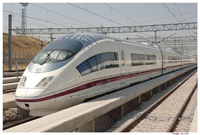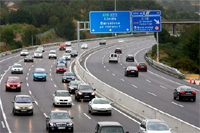
Arriving and moving around
Barcelona is very well connected by land and air, and, being on the Mediterranean coast, also by sea.
 Arriving at El Prat
Arriving at El Prat |
By Air: Barcelona airport is at Prat de Llobregat, only 12 kilometres from the city and with excellent connections to the city centre. The airport operates more than 800 flights every day. Its capacity has been doubled with the inauguration of the new terminal, T1, in 2009. |
Getting to the city from Barcelona airport:
Train: A train leaves the airport for Barcelona every 20 minutes and takes 30 minutes to reach the city centre (Plaça de Catalunya). To find out the times and fares, go to the "RENFE" (Spanish railways) website.
Bus: Another way to get to the city is by bus. The service, which runs from 6am to 1am, with stops in Plaça d’Espanya, Gran Via Corts Catalanes /Comte d'Urgell, Pl. Universitat and Pl. Catalunya , is called "Aerobus", times and fares are available at the website.
At night: There is also a night bus, the N17, which goes to Plaça de Catalunya and runs every 20 minutes between 10 p.m. and 5 a.m.
Taxi: Another option is to take one of the official city taxis. These are yellow and black in Barcelona and a green light on the roof indicates they are available.
Car rental: If you prefer to go to the city by yourself, the following major car rental companies are at the airport
More information: "Barcelona Airport website"
 Cruise Terminal © Espai d'Imatge, Turisme de Barcelona |
By sea: Barcelona’s port is one of the biggest on the Mediterranean coast, so there are lots of ways to get here. Below you can see the different options. Ferries: If you come to Barcelona by sea, you will come to the port, where the regular shipping lines dock along with the ferries that link the city to national destinations like Majorca, Minorca and Ibiza (the Balearics) and foreign destinations like Genoa (Italy). |
Cruise ships: Barcelona is Europe’s leading cruise port and the world’s fourth busiest. The port of Barcelona is the base for many of the major cruise companies operating in the western Mediterranean.
Private boats: If you arrive on board your own boat and it is not more than 20 metres in length, you can contact the Reial Club Marítim de Barcelona, which has moorings available throughout the year for vessels visiting the city. Other sporting ports and clubs in Barcelona city and Barcelona province include the Reial Club Nàutic de Barcelona, Club de Mar Port Olímpic de Barcelona, Port Ginesta (Sitges), Aiguadolç Port de Sitges, Club Nàutic Garraf and Port del Masnou.
More information: "Port of Barcelona website."
 High-speed train |
By train: The city’s main train station is Estació de Sants, which is where national and international trains arrive, as well as the high-speed train, the AVE, which links Barcelona with Madrid, Lleida, Camp de Tarragona and Zaragoza. Since the new trans-Pyrennes Perthus tunnel opened in December 2010 the high-speed line between Spain and France has become a reality. Trains are expected to reach to Barcelona in 2013. |
Although all trains stop at Sants, the city has a number of other stations.
- Estació de França, near Parc de la Ciutadella.
- Plaça de Catalunya, in the city centre, at Plaça de Catalunya.
- Clot-Aragó, near Plaça de les Glòries.
- Arc de Triomf, next to the Arc de Triomf and has a connection with Barcelona Nord bus station.
- Passeig de Gràcia, at the heart of the Modernista route.
Barcelona is also served by the “Ferrocarrils de la Generalitat de Catalunya” (FGC). Although they run short and medium distance inter-city train services, these are integrated into the city’s underground network, the Metro, which means you can use the T-10, a combined ticket for 10 journeys on city buses and the underground as well as the FGC trains. There are three FGC lines (6, 7 and 8) integrated in the metropolitan transport system, which runs the underground in the city itself.
More information:
 Barcelona Nord bus station |
By bus: The main bus station is Barcelona Nord, which is very near the centre, by the Arc de Triomf, although most buses stop at Sants station. There are national and international services and usually it is not necessary to book in advance. The bus station is linked to the city’s underground system. Look at the map with the different underground lines and bus routes on the "TMB website". More information: "Barcelona Nord bus station website " |
 AP-7 Highway |
By road: Barcelona has very good road links, including the main roads and motorways. The AP-7 (known as the E-15 in Europe) links the city to the coast, north and south, and connects France with the east of Spain. In Spain and the European Union motorways (identified by their blue signs) are toll roads and you can pay by credit card or cash. If you want to avoid them, choose the national roads, indicated by the letter N in front of the road number. If you want to get round the city easily and without crossing all of it, there are some fast ring roads or bypasses known as rondes: the “Ronda del Litoral” (follows the coast), the “Ronda de Dalt” (goes round the North of the city) and the “Ronda del Mig” (crosses the city from North to South). |
Moving around
Barcelona has an excellent public transport network.
Metro: Seven metro lines cover a distance of 101.8 kilometres and serve 138 stations. The city also has a funicular railway.
TMB ("Barcelona Metropolitan Transport") bus network operates a fleet of over 1,000 buses. All of them are adapted for people with reduced mobility.
Tram: Barcelona tramway system, known as the Tram, was relaunched in 2004. This means of transport, which had been abolished in 1971, is now an accessible, environmentally friendly, fast and comfortable system.
Taxis: A fleet of 10,500 taxis can be easily recognized by their yellow and black livery.
 Barcelona Bus Turistic © Espai d'Imatge, Turisme de Barcelona |
Tourist transport:
The city has a series of means of transport that will take you to the most interesting places in the city. Sustainable mobility and alternative means of transport are also an option. For complete details please "click here" |
How to get the best of your visit: For some tips to get the best of your visit to the city you can take a look at "“Barcelona Turisme” web site.



